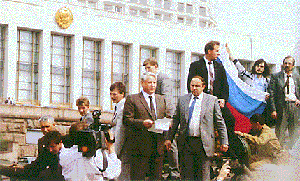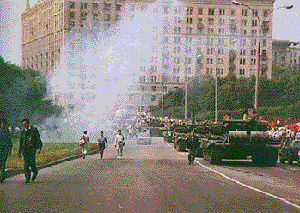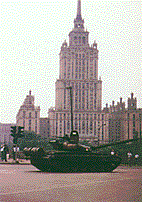| On the final day in July 1991, the Strategic Arms Reduction Treaty was signed in the Kremlin. Speaking to an audience of diplomats, legislators, military leaders, and television viewers worldwide, President Bush defended the treaty: "Neither side won unilateral advantage over the other. Both sides committed themselves instead to achieving a strong effective treaty." President Gorbachev struck a similar theme: "Here in Moscow, some will point to our unilateral concessions, while in Washington there will be talk about concessions made to the Soviet Union. . . . Sharp criticism is to be expected from those who want faster and more ambitious steps toward abolishing nuclear weapons. In other words, this treaty will have to be defended."17 | ||
| Collapse of the Soviet Union, Continuity of Arms Control | ||
 Russian President Boris Yeltsin, standing on a Soviet tank, declared the coup d'etat illegal and called for a general strike and civil disobedience, Moscow, August 19, 1991. |
Within three weeks of the signing of the START Treaty the Soviet government was threatened on August 19 by a coup d'etat. The coup leaders acted to halt implementation of the All-Union Treaty, which ceded significant powers to Russia and the other Soviet republics. However, in the early hours of the revolution the leaders appeared hesitant and uncertain. Opposition appeared quickly. Russian President Boris Yeltsin and thousands of his supporters went into the streets of Moscow, protesting the unconstitutional seizure of power.18 By chance, Master Sergeant Gary Marino and Joe Murphy, two American INF Treaty inspectors from Votkinsk, were in Moscow picking up the weekly mail when the revolution began. As they walked out of the U.S. Embassy, Marino noticed "the ground began shaking as the sound of tanks became deafening outside of the perimeter fence. As I ran back to the hotel...tank after tank rolled methodically toward the Kremlin. While crossing the Moscow River, I looked down Kutuzovsky Prospekt at the endless number of tanks, armored personnel carriers, and other military vehicles."19 |

